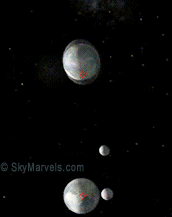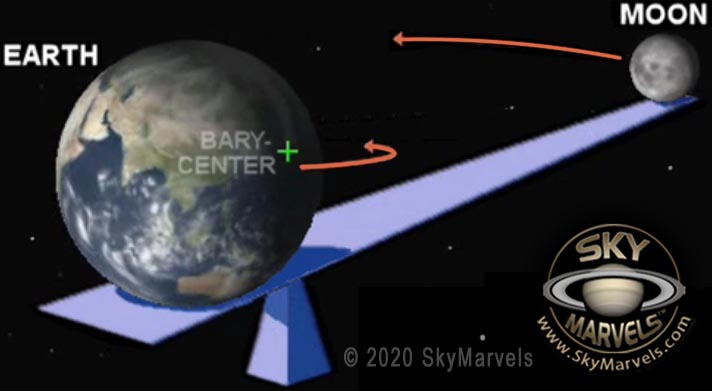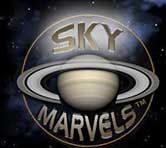


THE EARTH-MOON BARYCENTER
Earth's and the Moon's Intriguing "Balance Point"

The Earth-Moon barycenter is the "center of mass" of Earth and the Moon, indicated by the red diamonds in the animation above. This is the "balance point" of Earth and our Moon, and it directly governs their orbital motion. Though the proportions of the animation above are exaggerated for emphasis, the motions clearly suggest the intriguing dynamics of two different-sized celestial bodies orbitting one another. And it should quickly become apparent that—though we often say that the Moon orbits Earth—it is actually more accurate to say that they both orbit their barycenter! Below are a scrollable image and another animation that highlight both the concepts and details of the Earth-Moon barycenter.

Of course it turns out that these "balance points" are quite common in the universe, even in our solar system itself. The Pluto-Charon barycenter and the Solar System barycenter are probably two of the best-known ex- amples. But sadly, any discussion of the Earth-Moon barycenter—and of most barycenters in general actually —is often quite limited or entirely neglected, even in some of the better astronomical texts. Yet scientists are discovering that Earth's and the Moon's motion around their barycenter may have profound effects, effects un- imagined just a few decades ago. For example, some scientists suggest that the Earth-Moon barycenter's mo- tion below Earth's surface may influence earthquakes! Use our Lunar Orbit: View from the Sun interactive to see Earth's current apparent displacement east or west from the Earth-Moon barycenter. Viewed from the Sun, this displacement naturally appears most pronounced when the Moon is near First or Last Quarter.
THE MOON'S DISTANCE FROM EARTH
(in Earth Diameters)
Incidently, the Earth-Moon barycenter is particularly intriguing. This is because Earth's and the Moon's motions around it help give rise to our tides. The animation at the top of this page demonstrates this effect. While you can still find texts which maintain that only the tidal force of gravity is responsible for our tides, this fails to recognize that Earth and the Moon constitute a dynamic system. Actually gravity and centrifugal effect work in unison to raise our tides on both sides of Earth!
With the awesome online app Gravity Simulator you can study the intriguing Earth-Moon barycenter, changing many parameters. Speeding up the simulator (near top center) helps you see Earth's motion, but you'll have to look closely. Note that the trails—which can be turned off and on near the top—also show which parts of each lunar orbit are above and below the Ecliptic. Very cool!
Home Intro News Gallery Sky-Gifts Bonuses Tips
Learning Ctr Help Links Credits Legal Contact Us
© 2007-
by Gary M. Winter. All rights reserved.
Interested in political cartoons and humor?
Check out The HIPPLOMATS™.
SkyMarvels, Sky Marvels, SkyMarvels.com, Earth-Moon Barycenter, celestia4all, celestiaforall, CELESTIA, astronomy, space, simulations, animations, downloadable astronomy posters, stars, planets, Inner Planets, Outer Planets, Inferior Planets, Superior Planets, moons, asteroids, comets, Oort Cloud, galaxy, galaxies, Milky Way, Andromeda, globular clusters, binaries, quasars, black holes, supermassive black holes, telescope, telescopes, planetarium, software, freestuff, satellites, add-ons, addons, scripts, eclipses, Solar Eclipses, Lunar Eclipses, Solar Eclipse Finder, Lunar Eclipse Finder, mutual eclipses, transits, occultations, Solar System, CELES-TOOLS, celeSTARrium, CELX, CELX programming, Freebies, multiple views, atronomical unit, light year, parsec, meteors, meteor showers, Perseids, Geminids, Leonids, barycenter, time, Time Zones, tides, alignments, conjunctions, oppositions, seasons, apogees, perigees, aphelion, perihelion, Earth, Luna, Mercury, Venus, Mars, Jupiter, Galilean Moons, Io, Europa, Ganymede, Callisto, Saturn, Titan, rings, Uranus, Neptune, Triton, E-MSpectrum, electromagnetic spectrum, astronaut, equinoxes, solstices, precession, rotation, spin, inclination, tilt, Ecliptic, orbits, ellipse, parabola, hyperbola

